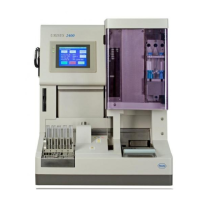URISYS 2400 Glossary
Racks - TS transfer base
Roche Diagnostics
Operator’s Manual · Version 1.0 G-3
Racks Roche Diagnostics 5-position standard
racks that must be used to carry sample tubes into
the analyzer.
Rack tray Trays for loading racks onto the analyzer
and removing processed racks from the analyzer.
Rack ID label All racks must have a barcode for
identification of the rack (routine, controls, or wash
samples) and for retrieving samples after serial
measurements.
Range table Table that assigns reflectance values
(obtained from test strip pads) or transmissions
(clarity) to concentrations or qualitative results.
Reflected light intensity The amount of light
that is reflected from the test pad and measured by
the photodiode detector.
Reference plate Internal gray plastic plate that is
measured first and used as a reference for the
reflectance measurements of the test strip pads.
Reflectance value Portion of reflected light,
calculated by the microprocessor and expressed as a
percentage.
Rinse station The area into which excess urine is
ejected and where the needle is washed with water
before the next sample is taken.
Sampling Stop Status The status of the analyzer
changes to Sampling Stop or S.Stop when there are
no more racks on the rack input line or when the
analyzer cannot continue with sampling.
Semi-quantitative determination
Measurement of analytes or features with numerical
result classifications.
Sequence number Consecutive number assigned
to each sample and that is increased automatically
with each measurement.
Special functions Analyzer software functions
that are password-protected to avoid accidental
modifications.
Specific gravity The ratio of the density of urine
to the density of water.
Specific gravity calibration This calibration is
based on the measurement of calibration solutions
of known refractive indices.
Start conditions Before starting analysis, certain
conditions can be confirmed or changed using the
[Start Condition] screen, such as starting sequence
number, operator ID, host ON/OFF line, and print
mode.
STAT sample An emergency sample that can be
measured in-between a run of routine samples with
priority by using the STAT function on the [Routine
Monitor] screen.
Stand-By status The non-operational status,
which follows Stop, that the analyzer must always be
in for the processing of data, inputting of criteria, or
the setting of parameters.
Strip waste container A container located on the
right side of the analyzer in which used test strips
are deposited.
System parameters Analyzer settings that can be
selected by the operator such as barcode setup, host
communication parameters, and others.
Test parameters (1) Software menu for the
definition of parameters related to sample analysis
and result reporting. (2) Parameters of the test strip
itself, such as glucose, protein, and so on.
Test strip Chemical reagent strip containing ten
individual test pads that are used to test for different
analytes or features of urine or control samples.
Toggle function Function of a button on the
touch screen to call up different settings.
Touch screen An interactive screen designed to
make navigation through the menus and input of
data and settings consistent and convenient. Also
known as user interface screen.
TS transfer base A component of the
URISYS 2400 analyzer on which test strips are
wetted with the sample, incubated, transferred to
the photometer, and measured.
R
G
S
G
T
G

